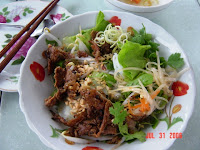I finally made it to Vietnam's capital and second largest city after surviving a long, grueling and crowded bus ride from Hue. It was incredulous how for a third of the way, I gradually gave up half of my seat to a man and his young son (who was initially sitting on his father's lap and hence, a non-paying passenger). The ordeal was exacerbated by the terrible B.O. from the passengers around me. Also, I saw a woman and a man sleeping on the floor of the bus in the middle aisle AND this guy behind me kept shoving his stinking foot on to my right arm rest. My patience, which was limited to begin-with, was tested on that overnight bus ride to Hanoi. Eventually, I told the man next to me to sit his son elsewhere because I could not sleep with his son's body rubbing against my left arm and thigh. I was SO glad to arrive in Hanoi at 7 that morning.
French influences were strong in Hanoi - in the promenades and large mansions, for instance. Hanoi was after all the capital of French Indochina from 1902 to 1954. Notwithstanding the French influence, communism is now the order of the day and Hanoi the capital of the Socialist Republic of Vietnam (SRV). The visit to Ho Chi Minh's mausoleum was markedly solemn and serious as all visitors must be in proper attire (no sleeveless shirts, for instance) to show reverence to their deceased communist elder. I also visited the Dong Xuan market, Lenin Park, and One Pillar Pagoda (Chua Mot Cot - built by Emperor Ly Thai Tong, 1028-54, to represent a lotus blossom, a symbol of purity rising out of a sea of sorrow). Unfortunately, I didn't have time to visit the other attractions, such as the Museum of Literature, in Hanoi.
A 3.5 hour bus ride from Hanoi to Halong Bay city was also futile as we had to turn back in the face of an approaching storm, a category 3 typhoon Henry. Since we couldn't go out to the Bay, we had a good Vietnamese lunch on the docked boat before we headed back to Hanoi. The force majeure was a bummer but at least I got to see the Halong Bay islets from land. All these meant that I ought to do a return trip to northern Vietnam and spend a few nights at the bay for kayaking, exploring, etc.; if I do, I'll include Sapa in the itinerary, which I heard will need 4 full days alone. Many people I met on the trip had raved about the hillside indigenous village.
(Click on any image for a(n) enlarged / gallery view)
Above: My first meal in Hanoi, with fellow traveler, Wilson
Above left: The Ho Chi Minh Mausoleum memorial; Above right: The Presidential Palace


Above right: "Cha gio" is a specialty of Hanoi
Above: "Cha Ca La Vong" a famous grilled fish restaurant































































































